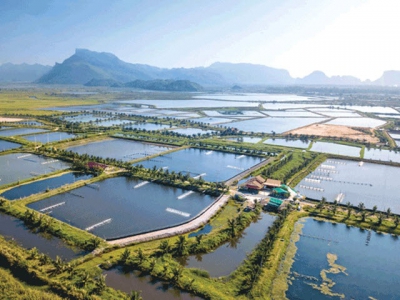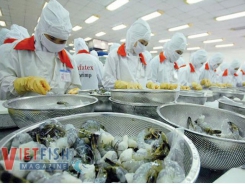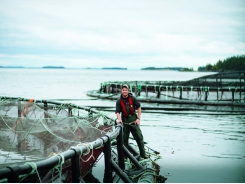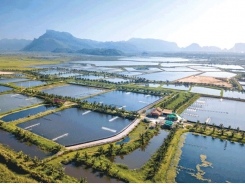Land Based Sustainable Aquaculture Strategy - Part 2

3/ Species Selection
Introduction
Aquaculture businesses and the species they culture are not restricted to the production of protein for human consumption. They can include production for conservation or recreational stockings, aquarium trade, production of pharmaceuticals or specialist health products, jewellery and feeds for other cultured/farmed organisms.
The decision to culture a specific species is determined by many factors, including:
- Is the species permitted for your intended aquaculture production method and location?
- Is there a ready supply of juvenile stock from hatcheries or will you need to breed the species yourself?
- Market analysis (eg. acceptability of product at a price that ensures a viable business);
- The biological feasibility of culturing the species (degree of control over the life cycle, spawning, egg incubation, larval and juvenile rearing or availability, growout and feed conversion, sensitivity to crowding, disease and handling); feed sources, availability and suitability to meet the physiological requirements of the species;
- Do you go for one or more species? (and if more than one, which species are most compatible);
- Site specific attributes (eg. size required to be profitable, degree of flood liability and associated development limits or controls, climate, water quality and quantity)
- Management issues, including disease management
Generally a species that is already successfully cultured is selected however, this should not deter investigating a new species provided careful planning is undertaken including:
- Preliminary screening – collection of information of the ecology/biology of the species and any legal constraints and some investigation of market assessment;
- Pilot study – focusing on the general physiological/environmental requirements of the species; reproduction, growth, nutrition, survival, growout trials and the economic feasibility;
- Commercial trial – construction of full size culture units, spawning runs, information on costs/profits and handling of large volumes;
- Full production – increase in number of culture units and hatchery output, suitable site has been selected and capital organised, further market development.
Translocation policy and species selection
Translocation is the introduction of animals or plants to an area to which they are not endemic and includes genetically distinct populations of endemic species. Industry & Investment NSW aims to protect indigenous (native) species from non-indigenous species and this may limit your choice of species or how you farm.
All proposals for land based aquaculture must be assessed according to the National Translocation Policy Guidelines. The guidelines set out a risk assessment process for considering translocation issues.
Translocation of non-indigenous species can be approved in some catchments (eg. trout stocking for recreational fishing) . However, some freshwater species that are capable of breeding in certain NSW regions that are not endemic have been assessed as high risk and have been determined as high security species. There are stricter requirements in terms of site selection, design and operational parameters for high security species.
Translocation issues may vary as new knowledge on a species is obtained or as new species enter culture. Therefore, it is imperative that when you consider a species to be cultured, you consult with I&I NSW to ascertain if it has any specific translocation issues.
4/ The main principles in swapping chemistry for aquaculture in NSW
- Non-endemic marine species to NSW cannot be translocated into estuarine or marine semi closed or open systems.
- Non-endemic species to NSW may be required to meet prescribed health testing protocols for stock to be translocated from interstate.
- Non-endemic species to NSW with high security status are generally permitted only in tank aquaculture. Stock imported from outside of NSW must be certified disease free in accordance with any current I&I NSW disease testing protocols which may also cover discharge water treatment and disposal.
- Non-endemic species to a region with a high security status are only permitted if site selection, design and operational components meet the relevant AIDP performance criteria.
- Other non-endemic species to a region such as Silver, Golden perch and Yabbies are permitted in freshwater pond aquaculture that meet the relevant AIDP performance criteria.
NSW has evaluated the risk of culturing a number of species in Table 3. Any new species proposed for culture will require to undergo an evaluation of its associated risks. Under this risk management approach a species may be prohibited for culture if any associated risks can not be adequately addressed.
It should be noted that silver perch are not permitted in extensive aquaculture and eels are not permitted under a Class E aquaculture permit.
Related news
Tools

Phối trộn thức ăn chăn nuôi

Pha dung dịch thủy canh

Định mức cho tôm ăn

Phối trộn phân bón NPK

Xác định tỷ lệ tôm sống

Chuyển đổi đơn vị phân bón

Xác định công suất sục khí

Chuyển đổi đơn vị tôm

Tính diện tích nhà kính

Tính thể tích ao




 Land Based Sustainable Aquaculture Strategy - Part 3
Land Based Sustainable Aquaculture Strategy - Part 3  Land Based Sustainable Aquaculture Strategy - Part 1
Land Based Sustainable Aquaculture Strategy - Part 1